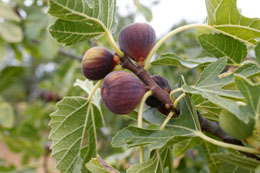This article provides certain tips for fig tree care, as this highly nutritious and edible fruit tree needs adequate care.

Native to southwest Asia and the eastern Mediterranean region, the fig tree is a large deciduous tree grown for its highly nutritious and edible fruit. Botanically, it is known as
Ficus carica, and belongs to the
Moraceae family. The fruits can be eaten fresh, though they can't be stored for too long as they are perishable. To preserve them, they are often dried. Of all the trees, one can find many parables relating to this tree in the bible. Understanding the basics about its care will ensure that you always have a healthy plant in your garden.
Characteristics
- This plant can attain a height anywhere between 10 to 50 feet depending upon the type of cultivator.
- With over 600 different types of this fruit, one can easily decide which one would suit the landscape.
- Its trunk is large and thick with nodes on it, with its sap emitting a milky latex that can irritate the skin.
- It has a wider spread than its height, with branches spreading out in its early growing years, up to 15 feet and below, with multiple branching close to its trunk. It is regarded more as a shrub.
- Its branches can be trained to be espaliered, especially when they are being grown indoors or in a container.
- Its leaves are single, alternate, deeply-lobed, and bright green with rough hair on the upper side and a soft underside.
- It bears flowers inside the green fruits, hence can't be seen. Pollination takes place depending upon the type.
- Its fruit bearing occurs in two phases, for most common varieties, the first yield (breba crop) is borne in the spring on last season's growth, and the second, which is the main crop, is borne in fall on the new growth. The second yield is superior; quality and quantity wise.
- As the fruit matures, its peel hardens. Upon ripening, it cracks open exposing the white, jelly-like flesh bounding a seed within.
Propagation
Figs are preferably propagated by cuttings, as they do not come true through seeds. Although you will easily get saplings from nurseries, try to use root cuttings on your own. Select a young, one year old twig with no diseases, no blackening or browning on it. Cut it with a sharp shear, dip it in a rooting hormone, and allow the roots to form undisturbed in a moist place. Once they have sprouted roots, plant it. Do not transplant a young one, while it is starting a new growth, as it will kill them. One can even try various grafting methods for propagation.
Planting and Care
It can be grown indoors as well as outdoors. Indoor ones grown in containers are ideally placed facing a south or south-west wall, and trained upon horizontal wires attached to a wall. But, they do need sunlight all day to ripen the fruit. If one is growing it outdoors, then give it a large space, as they will shade out anything growing beneath. Its roots can spread out quite a bit. So, if it's in a container, then while replacing soil every three years, lightly trim the roots; and then, add more soil to it. Fill the pot again with soil-based compost, and plant it at the same depth as previously grown. Once you have planted it, water regularly until fully established. Do not use too many fertilizers, as too much nitrogen promotes leaf growth and hampers fruit yield. Its succulent trunk and branches are very sensitive to sun damage, so give them a coating of whitewash, especially if they are exposed.
Pruning
Pruning is essential only during the initial years. How one goes about pruning actually depends upon how the fruit is going to be used; fresh or dried. As the yield is borne on previous year's growth, avoid winter pruning. It's best to prune after the main crop has been harvested. If the plant needs heavy pruning because of diseases, then whitewash the entire shrub.
This was all about fig tree care. Its roots are a favorite food of gophers, that can cause extensive damage to the tree. Regular use of insecticides is a part of care routine, just as watering, fertilizing, and pruning is. Well then, get ready for your harvest, but allow them to ripen fully before you pick them. Fresh fruits can be stored in the refrigerator for only 2 - 3 days, and the dried ones for six to eight months. So, go ahead and grow this wonderful shrub so that you can have a lifelong supply of its fruit!






 Native to southwest Asia and the eastern Mediterranean region, the fig tree is a large deciduous tree grown for its highly nutritious and edible fruit. Botanically, it is known as Ficus carica, and belongs to the Moraceae family. The fruits can be eaten fresh, though they can't be stored for too long as they are perishable. To preserve them, they are often dried. Of all the trees, one can find many parables relating to this tree in the bible. Understanding the basics about its care will ensure that you always have a healthy plant in your garden.
Native to southwest Asia and the eastern Mediterranean region, the fig tree is a large deciduous tree grown for its highly nutritious and edible fruit. Botanically, it is known as Ficus carica, and belongs to the Moraceae family. The fruits can be eaten fresh, though they can't be stored for too long as they are perishable. To preserve them, they are often dried. Of all the trees, one can find many parables relating to this tree in the bible. Understanding the basics about its care will ensure that you always have a healthy plant in your garden.